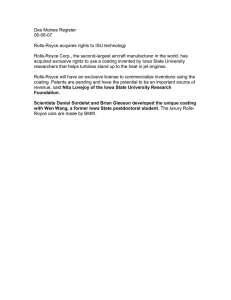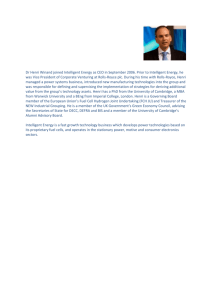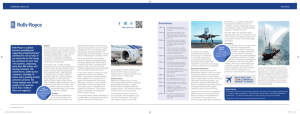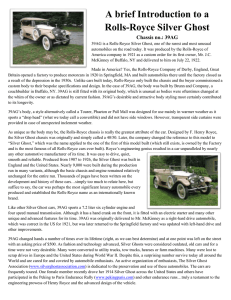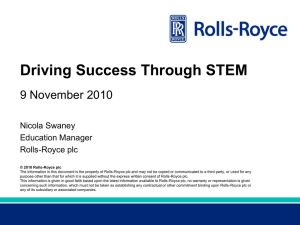Document 10974273
advertisement
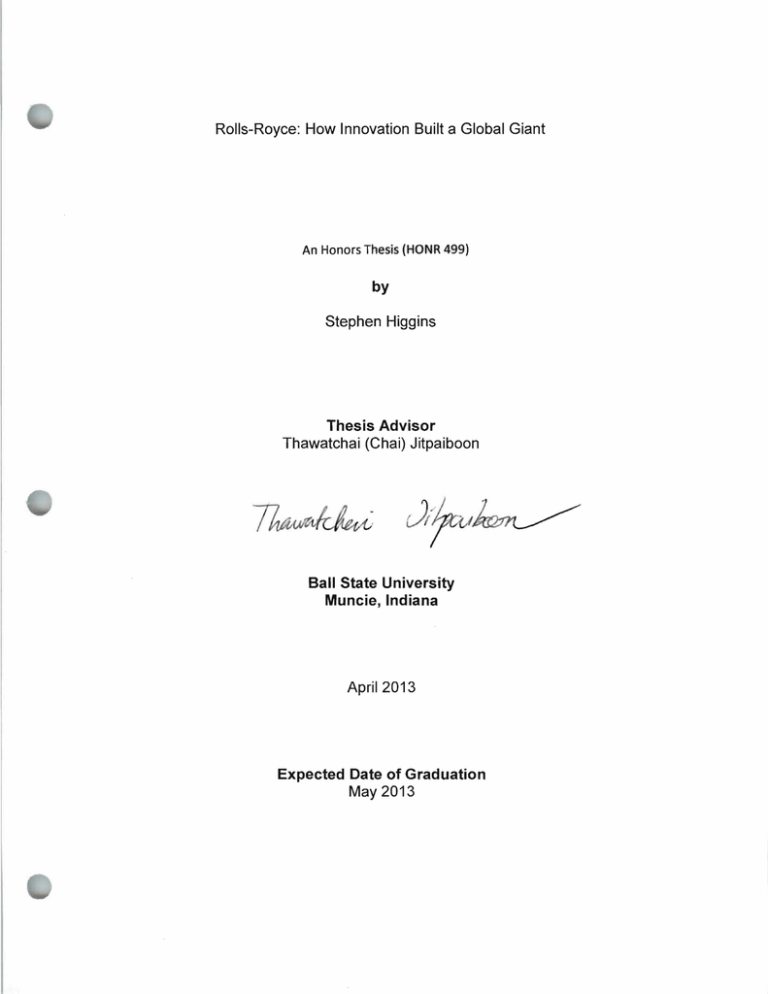
Rolls-Royce: How Innovation Built a Global Giant
An Honors Thesis (IHONR 499)
by
Stephen Higgins
Thesis Advisor
Thawatchai (Chai) Jitpaiboon
Ball State University Muncie, Indiana April 2013
Expected Date of Graduation
May 2013
Abstract
For most people, the name Rolls-Royce brings images of lUxury vehicles to mind.
However, today's Rolls-Royce has nothing to do with the line of motor cars. Instead it
has developed into a global leader in power generation for the civil and defense
aerospace, marine, energy, and nuclear industries. These achievements have been
reached because of the technological innovations Rolls-Royce has made and
transferred to its operations and products. By looking at where the company started,
where it is today, and where it is heading gives people an understanding of what RollsRoyce really is: reliability, integrity, and innovation. This thesis explores Rolls-Royce's
innovations in their business philosophies, products, and future programs.
-------41(
1
)1-----­
Acknowledgements
I would like to thank Dr. Chai Jitpaiboon for advising me through this project. The insight
and knowledge he has given me during my college career has helped me not only
complete this thesis but also become a valuable asset in the workplace.
I would like to thank Rolls-Royce for the opportunity to intern at its Indianapolis facility
the past three summers. This project would not have been possible had it not been for
the experience and knowledge I gained first hand from the renlarkable people I was
able to work with.
I would like to thank Ball State University as well as the Honors College for providing the
education and the environment needed to grow into the person I have beconle. I anl
very grateful for the Presidential Scholarship that helped nle work to accomplish my
degree.
I would like to thank my family for the constant support and desire for me to do my best
these past four years. Without you I would still be far from my achievements.
I would like to thank Jacob Sowers for his assistance with the final proofreading of this
project. It has been an amazing four years of friendship.
--------I(
2
)1--------­
Contents
Abstract............................................................................................................................1 Acknowledgements ..........................................................................................................2 What is Innovation? .........................................................................................................4 A Brief History of Innovation ............................................................................................4 Innovation in the Workplace .............................................................................................5 Company Profile ..............................................................................................................6 Rolls-Royce Plays its Part in Creating History .................................................................8 Key Business Decisions ...............................................................................................8 Key Products ..............................................................................................................13 A Current Leader in the Industry ....................................................................................15 Future Projects for the Company ...................................................................................18 Energy ........................................................................................................................18 Marine ........................................................................................................................20 Civil & Defense Aerospace .........................................................................................22 Conclusion ......................................................................................................................24 Works Cited ...................................................................................................................26 ----~(
3
)1------­
What is Innovation?
Innovation is "the introduction of something new (idea, method, or device)"
[Innovation]. The idea of innovation is about producing better ideas or products that
bring about advancements in certain fields or society as a whole. A true innovator
should begin without a thought to profit, but rather look to make life easier. In the fast
paced world we live in today, innovations are being made every day. No idea is too
small and innovators come from all walks of life.
A Brief History of Innovation
Darryl! Pines stated that "The future economic growth and competitiveness of the
United States depends on our capacity to innovate." Without innovation, today's society
would not exist. Remember learning about the Stone Age in school? Without members
of society taking the initiative to come up with ideas to better not only their lives but the
lives of everyone around them, we would still be living in caves just like the
Australopithecus (mankind's closest ancestor).
The history of innovation started with the first human society whon1 began the
fashioning of tools out of stone and bone, "including the first eyed needles presumably
for making clothing" [Hirst]. This was the early beginning of tailoring and eventually led
to the clothing we wear today. These early societies also built primitive housing to
protect themselves from the elen1ents, organized hunting to provide food and materials
for their community, and created art through which they utilized to convey the ideas of
their society. These ideas laid the groundwork for the in1portant principles we find in our
society today.
----------~(
4
)~-----------
The peoples that followed these early humans advanced their societies even
further, conceptualizing methods of farming and domestication. The agricultural industry
of today exists because of these primitive foundations. Later societies began to extract
metals from the ground to be used for stronger tools and weapons. The mining industry
and its infrastructure of today are results of early practices. The wheel, one of the most
important innovations of the history of man, was created and expounded upon by these
early civilizations. The basic concepts of "states", economics, politics, and religion have
their roots in early civilizations.
Innovators are the trailblazers of society, creating new and exciting paths to
follow. Without a past laying down the foundations for mankind to continue to build on,
every intricate detail of our society today would not exist. The concept of innovaton has
resonated well throughout Rolls-Royce's history. It has built upon some of the most
historically important innovations to consistently bring new products to the market.
Innovation in the Workplace
Innovation in the workplace is not the same thing as inventing. "For businesses,
this could mean implementing new ideas, creating dynamic products or improving your
existing services. Innovation can be a catalyst for the growth and success of your
business, and help you adapt and grow in the marketplace" [Innovation I What Is
Innovation?]. Innovation is not only about moving a cornpany and its products forward; it
is also about moving society and the world forward, coming up with products that make
life easier, and making tasks more manageable.
Innovations in the energy and aerospace industries have been important for the
world to expand and will continue to be important as environmental and space
-------1(
5
)1-----­
exploration becomes advantageous venues, especially for government programs.
Darryll Pines agrees stating that "Innovation in aerospace has historically kept the U.S.
at the forefront of technology advances and helped create new industries, such as the
commercial transport of people and cargo, unmanned aerial systems for civilian and
military missions, and, more recently, commercial space travel." Rolls-Royce has been
a leader of generating, collaborating, and manufacturing innovations in the aerospace
industry globally since 1914.
Company Profile
Contrary to the misconception of many people, the company Rolls-Royce does
not manufacture vehicles. Rolls-Royce Limited, the once manufacturer of Rolls-Royce
vehicles, sold the rights of its vehicles to BMW, creating the company Rolls-Royce
Motor Cars. This allowed what is now Rolls-Royce PLC. to focus on the aerospace
industry while keeping the highly recognized and marketable Rolls-Royce name and
logo.
Today Rolls-Royce is a leader in the aerospace industry. It manufactures
engines for both civil and military aircraft, marine propulsion units, as well as energy and
nuclear systems. Currently there are over 12,000 engines powering more than 30 types
of civil aircraft. The company has a line of eight engine models for large aircraft, eight
engine models for small and medium aircraft, and four engine models for helicopters.
Over 300 customers rely on Rolls-Royce to transport people and freight around the
world every day. In 2012, the operating civil engines in the market logged over 20
million hours of flight.
- - --
--t(
6
)1-----­
Rolls-Royce is second in the world for military defense applications, providing
engines for six jets, eight helicopters, six transport vehicles, nine tactical aircraft, and six
UAV's (unmanned aerial vehicles). The customer base for these products stretches
across 103 countries. Currently over 18,000 engines are providing air power for 160
different armed forces. The signature MissionCare packages that come with these
military engines provide an aftermarket service program exclusive for Rolls-Royce
customers.
In the marine market Rolls-Royce has become a world leader by offering
products for an entire vessel, not just the engine. On top of the range of diesel and gas
engines as well as gas turbines, a customer can also obtain control systems, on deck
machinery, electrical systems, ship design capabilities, ship lifts, stabilizing and
maneuvering gear, and multiple propulsion options. These products can be found on
over 30,000 vessels worldwide, including 70 different navy programs.
With environmental issues on the rise, Rolls-Royce focuses on providing the
highest quality energy products that minimize emissions. Rolls-Royce has also made its
mark in the oil and gas pumping industries as well as the energy power generation
industries by offering engines, compressors, and fuel cells. Their civil nuclear program
is beginning to pick up as new energy sources are being explored and reactor upkeep
projects are being purchased.
Rolls-Royce has adopted innovation as one of its core values. The company
demands that all employees keep an open mind and stay flexible to new ideas. It
encourages these ideas to come from all levels of its employees. The work culture that
has been instilled rests on constantly seeking to improve and not just, going along with
- - - -'- {
7
)t------­-
­
the market, instead striving to be a step ahead. This attitude has kept Rolls-Royce at
the forefront of its competitors, allowing it to develop higher levels of technology and
infrastructure, and providing its customers with products that bring more benefits to the
market at lower costs.
Rolls-Royce Plays its Part in Creating History
Key Business Decisions
In the late 1800s, Henry Royce was responsible for an electrical and mechanical
business and Charles Rolls was responsible for the London car company CS Rolls &
Co. In 1904, Henry Royce assembled his first motor car. When the two met later that
year no one could have guessed what would follow.
After the formation of the Rolls-Royce Company, Henry Royce and Charles Rolls
unveiled the company's first manufactured motor car, the Silver Ghost. After only being
on the market for one year, it was considered to be the top car around the world in
1907. It gave drivers a quieter, smoother ride than any other car on the market at that
time, and the gas mileage it could attain was astonishing for the vehicle's size. It
became such a luxurious car for the times that the "Silver Ghost remains to this day the
most desirable model among antique cars" [1907].
The great success of the Silver Ghost was halted by the start of the First World
War in 1914. To keep up with the demand of the time, Henry Royce came up with the
idea to produce an aero engine. Using the Silver Ghost's 40/50 horsepower engine as
the framework, the final manufactured product was coined the Eagle. Using aluminum
to forge the pistons and pressed steel to create the water jackets, the engine was able
to produce more than the desired 200 brake horsepower in an engine framework that
- - - ------1.(
8
)1---------­
weighed significantly less. This innovative design made it popular among the allied
nations during the war which resulted in it being installed on over half of the aircraft that
were in service. "The Eagle powered the first direct transatlantic flight as well as the first
flight from England to Australia" [Rolls-Royce] and was the company's foundation in the
aerospace industry.
In 1933 the company experienced tragedy with the death of Henry Royce. Before
his death, however, he experienced an "era of broken land, air and sea records" [Rolls­
Royce Motor] powered by the products he helped to create. His work on creating the R
Engine made these feats possible, adding to the now increasingly popular company.
Royce's final contribution to the company was his work on the Merlin.
The Second World War saw the company becoming a powerhouse in the
aerospace industry. Other aerospace companies had engine programs in development
or production for Britain to use in powering its air force, but limited capacity and
production problems plagued these competitors. "Thus it was the Merlin that had to
meet all Britain's in-line aero-engine needs for the early war years," [Dell] and the Merlin
did more than just deliver. Rolls-Royce decided to use ethylene glycol in place of water
as engine coolant. This innovation allowed its engines to feature a smaller radiator as
well as elirrlinated wing condensers. This greatly lowered the overall airplane weight,
allowing for faster and more maneuverable aircraft during dogfights.
Approaching the end of the war, Rolls-Royce had the technology to produce the
first jet engine in Britain, but it didn't have a project to apply it to. At this time Sir Frank
Whittle was trying to work with the company Rover to develop his idea for an aero gas
turbine engine. Rover did not have the resources and capacity to complete Whittle's
-------I(
9
) - - - - - --
- ­
project. A Rolls-Royce representative approached Whittle and Rover and worked out a
deal to take control of the project. By 1944 the Weiland was manufactured and powered
the Gloster Meteor fighter. Following the war Rolls-Royce made a full commitment to
the advancement of its gas turbine engine, opening the door to new possibilities in the
skies of Britain and around the world.
In 1953 Rolls-Royce released its revamped gas turbine engine to the civil
aviation market. The Dart, the first gas turbine aero engine to be accepted by the airline
industry, became the foundation for future gas turbines.
A few years earlier Rolls-Royce began development of
the Avon, the first axial flow engine. In 1952 the Avon
powered Comet "was about to make history, inaugurating
the world's first commercial jet service" [Engel]. This
aircraft initiated airline travel around the world. At the
same time Rolls-Royce had been working on the
Using four Rolls-Royce Avon
engines, the Comet was the
first commercial jet aircraft. Its
first flight carried 36
passengers the 23 hours from
London to Johannesburg.
Conway, the world's first turbofan jet engine. In 1960 it became the first turbofan engine
used by an airline service.
Up until 1950, the Royal Family used Daimler brand motor cars. Then Princess
Elizabeth and the Duke of Edinburgh broke this tradition by ordering a Phantom IV from
Rolls-Royce. The company took this extraordinary opportunity to be associated with
such a prestigious role and fine-tuned the vehicle to be fit only for royalty and heads of
state. Only 18 of these vehicles were ever made. According to the official website of
The British Monarchy, three of the eight vehicles used by today's Royal Family are RoII­
Royce's; this includes the original Phantom IV.
----------~(
10
)~----------
In the 1960s Rolls-Royce vehicles made their way into pop culture. The Yellow
Rolls-Royce featured a Phantom II. Famous musician John Lennon purchased a
Phanton1 V. He painted it in a very "Lennon" fashion, and it has now become an iconic
piece of American and British pop culture, traveling to museums as a central
showpiece.
Rolls-Royce then turned its focus on building its market share. During the war
there were six n1ajor manufacturers of aero engines. Two of the leaders, Bristol and
Armstrong Siddeley, merged together in 1959. A few years later the three small
manufacturers Blackburn, de Havilland, and Napier merged into Bristol
~iddeley
and
Rolls-Royce. Then finally in 1966, Bristol Siddeley merged into Rolls-Royce, uniting
Britain's aero engine manufacturers together and created a powerhouse that would
cOrTlpete on a global level. Rolls-Royce entered the global market by providing its
RB211 turbofan engine for the Lockheed TriStar. "This is the first foreign-made engine
to be chosen as the basic power for a major U.S.-built airliner" [Rolls-Royce RB211].
This engine was preferred by Lockheed because the RB211 used three shafts instead
of the two used by other engines. This pern1itted optimized speed and efficiency by the
engine and aircraft during flight. Rolls-Royce had successfully extended its name
around the world.
After leading the pack of foreign aero engine manufacturers into the U.S. market,
Rolls-Royce made history in a way that wasn't expected. The RB211 that helped make
the company's mark on the global market backfired, causing the company to declare
bankruptcy in 1971. This remains one of Britain's worst collapses of a corporation.
Reorganization was needed for the COrTlpany. Instead of dropping the RB211 project
--------~( 11 )~-------
that was the center of its problems, Rolls-Royce decided to take a much riskier path.
Not wanting to be known for such failure, the company put the RB211 program at the
center of its operations and in 1973 created a separate company led by BMW to
manufacture the vehicle line. Now focused on its aero engines, the company began
improving its technology, strategies, and operations.
By 1987 Rolls-Royce had fought its way back to the top. Through a number of
strategic mergers and acquisitions, Rolls-Royce was the only British con1pany with the
capabilities to provide power on land, on sea, and in the air. With production and profits
starting to rise, the company entered into the private sector.
The 1990s was a decade of continuous improvement and growth. An aero
engine joint venture was created to combine resources and technology between RR
and BMW. In the mid 90's Rolls-Royce made its first move into competition with U.S.
engine manufacturers, by acquiring the Allison Engine Company in Indianapolis. "Rolls­
Royce is broadening its product line and trying to make itself a more muscular
competitor against larger rivals like the General Electric Company and the Pratt &
Whitney division" [Stevenson]. Now with a new product line and greater capacity, Rolls­
Royce had a significant manufacturing presence worldwide in the defense and civil
aerospace industries. Rolls-Royce ended the decade with key acquisitions. First, the
company took full control of Cooper Rolls, an oil and gas joint venture it had created
with Cooper Energy Services, setting the foundation for future power generation
programs. It then acquired National Airmotive, allowing for the opportunity to offer repair
services in the United States and eventually leading to the creation of the Rolls-Royce
----------~(
12
)~-----------
Engine Services department. Finally, the acquisition of Vickers PLC. saw the entrance
of Rolls-Royce into the marine power industry.
In the early 2000s, Rolls-Royce and BMW ended their joint venture. Rolls-Royce
took full control of the aero engine business and BMW took control of the car business,
however it still pays Rolls-Royce royalties to maintain use of the RR name and logo.
This was a significance step, showing just how far Rolls-Royce had come from its
sin~lple
beginnings. It had now instilled itself as a global giant in the power generation
market.
Key Products
The Eagle was the beginning of aero engines for Rolls-Royce. This was a result
of taking innovative steps with its Silver Ghost car engine. From the basic car engine,
Rolls Royce made dramatic upgrades to support a larger bore, double the number of
cylinders for more power output, and enable it to be water-cooled. Rolls and Royce
wanted to produce an engine that could meet the need of power for ally aircraft during
the First World War; it had much larger success than initially thought, powering over half
of the ally aircraft. The company had difficulty keeping up with the demand once the
engine's true potential was realized. The Eagle was also used to power the first non­
stop transatlantic flight by John Alcock and Arthur Brown. This was a huge
accomplishment for the company and an innovative step forward for the world. Since its
initial production, the Eagle has powered over 45 different aircraft. It was also used as
the innovative foundation for two future engines, the Falcon and the Hawk.
In the late 1920s, Rolls-Royce manufactured the first R engine. This engine was
used to power Britain's entry into the Intercontinental Schneider Trophy seaplane
----------~(
13
)~-----------
contest, where it received first place. A few years later the R engine was used to break
the world airspeed record, twice. Further innovations saw the R engine used to break
the land speed record, twice; and the water speed record, three times. These
milestones of the '20s and '30s shed significant light onto the capabilities of Rolls-Royce
as an engine manufacturer and led to further advancements in the air, land, and sea
power generation. Innovation of the R engine eventually led to the Merlin, the final
engine to be designed by Henry Royce before his death. Later, it would also be used
as an innovative base for the Spitfire.
The RB 211, the engine that was responsible for sending the company into
bankruptcy in the early '70s, is also one of the most important engine models. The use
of three shafts, instead of the common two shaft engines on the market, put this engine
in the forefront of power capabilities. After the initial problems were resolved and the
company got back on a profitable track, numerous upgrades were made with the RB
211 as orders from airliners poured in. The great success of this engine n10del can still
be seen, as there are still two versions in production today. Further innovations to this
engine have lead to variants of it to be used as power generators in the energy sector
and propulsion systems in the marine industry.
------------~(
14
)~------------
The culmination of nearly a century of hard work,
determination, and innovative designs, resulted in the then
Pegasus and today's LiftSystem engines with short take off and
vertical landing (STOVL) abilities. Rolls-Royce is the only aero
engine manufacturer with the technological abilities to offer the
STOVL capabilities in its engines. The Pegasus engine allowed
the Harrier combat jet to rotate its engine to directly lift off of the
carriers at sea, then, rotate to provide the forward thrust of
ordinary aero engines. The engine can then be rotated again
The innovative
STOVL capabilities
of the Pegasus
engine can only be
manufactured by
Rolls-Royce.
providing allowance for the aircraft to land back on the carrier in much the same manner
as a helicopter. This innovative technology eliminated the need for a runway, resulting
in both a huge space and ultimately a huge cost savings. Rolls-Royce has now
advanced this technology even further and created the LiftSystem, a similar engine
concept used on the supersonic Lightening II combat jet. The LiftSystem improves on
the Pegasus capabilities and offers minimized costs and weight by using a fan system.
The R, RB211, Pegasus, and LiftSystem engines each signified a milestone for
Rolls-Royce. It is through the company's endeavor to innovate that have allowed these
engines to become trendsetters in their own right, and come to fruition years ahead of
the competition. The future will most likely witness these engines utilized as innovative
foundations for not only Rolls-Royce, but for an entire industry.
A Current Leader in the Industry
Today Rolls-Royce is the second largest civil aero engine company in the world.
In 2012, over half of Rolls-Royce's revenue came from the civil aerospace industry. The
----------~(
15
)~-----------
civil industry has proven to be the largest market for the company in the past, but has
seen a decline since the tragedy of September 11th. The company offers 20 different
engine models in three categories of aircraft: helicopters, small and medium engines,
and large engines. Rolls-Royce's TotalCare and Corporate care services offer
customers afternlarket opportunities not found at other companies. These services
provide over half of the civil aerospace revenue that Rolls-Royce collects annually.
Rolls-Royce has also become the second largest defense aero engine
manufacturer in the world. Last year 20 percent of revenues came fronl this industry.
The large number of future military contracts will only increase this percentage going
forward. Rolls-Royce offers 40 different engine models for six categories of aircraft:
combat jets, helicopters, transport aircraft, training aircraft, tactical aircraft, and
unmanned aerial vehicles. Rolls-Royce takes pride in its MissionCare service program
that has had strong results with the United States and United Kingdom militaries. This
service sector provides just under 50% of its defense aerospace revenues. To illustrate
the importance of innovation, Rolls-Royce receives 5 percent of its rnilitary revenue from
military engine development. The remaining 45%+ conles from the actual sales of
engines.
In addition to its civil and defense aero business sectors, Rolls-Royce has
become the global leader in nlarine propulsion solutions. Rolls-Royce attracts
customers in the marine industry because of its extensive product line. It offers control
systems, a range of on-deck machinery, electrical systems, and maneuvering
equipment. In addition, sixteen different propulsion systems are available, ranging from
Azimuth thrusters to waterjets to podded propulsion systems. These products account
------~(
16
) . . . . - - - . - - - -- ­
for nearly 60 percent of the revenue earned from this industry. The balance of the
revenue comes from Rolls-Royce's innovative ship designing technology that is
constantly improving efficiency features as well as aftermarket services, including
equipment support and upgrades, while reducing cost expenditures. With all of these
possibilities, customers can be assured that Rolls-Royce is a one-stop shop for their
marine solutions.
In addition, Rolls-Royce has become the global leader in energy solutions, with
products in the oil and gas punlping and exploration, power generation, and nuclear
sectors. Though the revenue in this industry is dominated by the services the company
provides, Rolls-Royce has begun investing in developing sustainable energy products.
Its oil and gas products are currently used in 24 countries and offer efficiency in some of
the most world's harshest environments. By innovatively reducing emissions while not
compromising output in its power generating systems, Rolls-Royce has become a
growing supplier sought worldwide. Its reputation for reliability is helping it expand into
the nuclear industry. Innovative developments in technology and capabilities resulted in
industry accreditations in 2011. These have begun to pave a path that will provide
future growth opportunities.
Rolls-Royce follows the motto "Trusted to Deliver Excellence." This means a lot
to the company as well as its customers. Rolls-Royce knows that without trust the
company will fail and the customers won't return. This trust has to be earned every day
in order for it to be successful. Rolls-Royce knows that in today's market companies
can't just deliver a product; they have taken it upon themselves to deliver the best
afternlarket services their customers can find. This ensures customer happiness and
--------I(
17
)t---------­
continued business. Excellence is a goal that requires constant innovation in
technology, practices, and products. With this motto at the forefront, Rolls-Royce will
continue to be known for its core values: reliability, integrity, and innovation.
Future Projects for the Company
Rolls-Royce continues to receive contracts in the four main industries in which it
competes. Each contract represents an opportunity to build on past projects and bring in
new technology and operations. The energy industry is beginning to gain a lot of
attention, and the marine industry continues to grow larger. The civil and defense
aerospace industries have always been a strongpoint for the company. These contracts
allow Rolls-Royce to continue to build upon its name and reputation for innovation.
Energy
Hitachi Ltd. came to Rolls-Royce to form a collaborative agreement on the
production, delivery, and installation of new nuclear reactors throughout the UK. Rolls­
Royce was chosen for this joint venture because of its advanced manufacturing,
engineering, and technical capabilities. Hitachi also commissioned Rolls-Royce to
develop innovative instrumentation and control systems to be installed with the reactors.
Being a part of this Advanced Boiling Water Reactor project will make Rolls-Royce a
synonymous name with nuclear energy initiatives.
Rolls-Royce is working on an upgrade for the RB211-Gzero gas generators used
by many energy customers. When installed, this upgrade will allow the systems to
create up to 10 percent more power by increasing air flow through the generator.
Installation of the new piece will only require minimal modifications to ensure customers
-----------I[
18
)1---------­
that the generator down-time is minimized. The success of this project will emphasis
Rolls-Royce's commitment to creating innovative sustainable energy resources.
Dolphin Energy Limited approached Rolls-Royce with a challenge to provide gas
turbine generators to be used on its subsea pipeline systenl. This innovative project will
create power for the largest energy-infrastructure projects to ever cross borders in the
Middle East. Dolphin has also contracted the TotalCare aftermarket service program to
increase the reliability of its generators for years to come. The success of these
generators will attract more customers to use Rolls-Royce energy systems on their
projects.
The Ministry of Defense chose Rolls-Royce to manufacture and install energy
reactors on its new nuclear powered submarine fleet. This contract will require Rolls­
Royce to innovate its reactor core facility with new technology and operations. The new
cutting edge facility will manufacture the cores while the submarines are being
developed. The Ministry of Defense chose Rolls-Royce for its growing nuclear reactor
system abilities which will ultimately lay the groundwork for future opportunities on
similar projects.
LUKOIL, the Russian oil conlpany, asked Rolls-Royce to supply it with gas
turbine generators to power its plant. LUKOIL chose Rolls-Royce because of the proven
reliability and high fuel efficiency Rolls-Royce has achieved from its generators. These
generators include Rolls-Royce's low emission technology, once again demonstrating
its continuous, innovative improvements towards negating environmental impact.
----------~[
19
)~------~~-
Marine
Fednav Limited, a Canadian company specializing in the operation of large, ice­
class vessels, selected Rolls-Royce to provide the propulsion for its new ship. The ship
will be traveling one of the toughest sea routes in the world, from northern Quebec to
Europe, by traversing the Arctic ice. To supply this new ice-breaking bulk carrier with
the power it will need to smash through the large areas of ice and protect the propulsion
system from being damaged by ice chunks, Rolls-Royce must manufacture a modified
propeller to fit inside a steel nozzle. The completion of this innovative project would
ensure future business with not only Fednav Limited, but other operators of ice-class
vessels, too.
Atlantico Sui, a shipyard located in Brazil, contracted Rolls-Royce to fully equip
drill ships it is building for the oil company Petrobras. Atlantico Sui came to Rolls-Royce
because of Rolls-Royce's reputation for innovative technology and products. The
propulsion systems will allow the drill ships to accurately maintain position in the rough
seas off the Brazilian coast while drilling. Rolls-Royce has already begun the design and
production of six thrusters and six diesel generators for each ship. With success of this
project, Rolls-Royce will build a reputation with a new customer and make a better
name for itself in the offshore drilling industry.
The Finnish Navy began a new project to build high-speed troop transport
vehicles. It chose Rolls-Royce to provide modified 40A3 water jets along with innovative
control systems for the water crafts. These vessels will be used in shallow waters at
high speeds for transportation of troops, medical and evacuation operations, and on­
--------t[
20
)t---------­
shore landing procedures. The challenge of this project is to improve the
maneuverability aspects of previous propulsion systems utilized.
Rolls-Royce accepted a contract from Jiangsu Eastern Heavy Industries Co. Ltd.
to fully design and equip new platform supply vessels used for transporting solid and
liquid products. Jiangsu wants Rolls-Royce to come up with an innovative vessel design
and equip it with all necessary gear, including the main engines, a propulsion system,
stabilizing thrusters, automated control systems, on deck tools, and other steering
equipment. This project presents Rolls-Royce the opportunity to further penetrate the
Chinese market.
The United States Navy turned to Rolls-Royce to innovate a new type of water jet
propulsion system that can be used on unmanned watercraft for intelligence,
surveillance, and reconnaissance missions. The Navy is looking for Rolls-Royce to
create the smallest water jet on the market in order to keep its craft completely silent
during missions, while still remaining highly efficient. For this project, Rolls-Royce will be
funded by the Small Business Innovative Research government program. The U.S.
Navy also chose Rolls-Royce to manufacture the propulsion system for its new era of
innovative ship-to-shore hovercraft vehicles. A key to winning this contract was Rolls­
Royce's ability to provide a modified version of an engine already in production and
utilized successfully by the Navy, thus decreasing the maintenance training required for
the troops to care for and service the engines. Rolls-Royce will also be responsible for
providing a gearbox system that will control the lift so the watercraft can "float" across
the water. Rolls-Royce will also design a new exhaust system to be used. These new
- -------t(
21
)--- - - -- - ­
watercraft will be used to rapidly deploy troops and equipment fronl the ships to the
shore. Success of these two programs would promise future projects from the Navy.
Rolls-Royce began designing the first installations of its new tunnel thrusters.
These propulsion systems are installed on the front and back of a vessel and allow it to
hold its position in rough seas. This innovative design creates substantially less noise
and vibration than other propeller systems currently being used. By using magnetic
force to create the propulsion, these new thrusters will increase power output over other
thrusters by 25 percent and significantly reduce weight. The successful installation and
use of these thrusters will attract customers away from other propulsion system
manufacturers.
One of the biggest innovation projects Rolls-Royce is bringing to the market is its
wave-piercing technology on hull ships. Currently wave piercing technology has only
been adapted onto smaller vessels such as catamarans. Rolls-Royce has adapted this
to be used on large offshore vessels with its UT 790 CD designs. This technology will
allow larger vessels out at sea to experience lower fuel consumption and a smoother
ride. Also, Rolls-Royce's hydrodynamic research center located in Sweden allows Rolls­
Royce to constantly test new, innovative models of propulsion. This facility continues to
result in highly efficient propulsion systems.
Civil & Defense Aerospace
In the Civil and Defense aerospace industries, most of the contracts Rolls-Royce
receives are for its one-of-a-kind aftermarket services. Rolls-Royce prides itself in its
MissionCare services for militaries and TotalCare services for civil customers. These
projects ensure the performance reliability of the aircraft.
--------I(
22
)1--------­
Along with the marine projects that the US Navy has chosen Rolls-Royce to
undergo, it has also signed a contract to provide its MissionCare services for the Navy's
training aircraft. This contract will require Rolls-Royce to handle the inventory of spare
parts for these aircraft as well as providing logistics and engineering services.
The US Air Force signed two contracts with the company. The first is to design a
new Highly Energy Efficient Turbine Engine (HEETE). This innovative project will result
in new advanced, fuel efficient engines that will be used on subsonic missions. Rolls­
Royce's work on this project will lay the foundation for future generations of energyefficient aero engines. The second contract is to create new enhancements for Rolls­
Royce's T56 engine. Using its innovative Accelerated Mission Testing, Rolls-Royce
aims to reduce fuel consumption by nearly 10 percent while increasing reliability 20
percent. These tests include looking into using innovative materials and designs to
decrease weight and increase aerodynamics. The success of this program would
decrease the engine emissions during flight.
The US Department of Defense (000) also came to
Rolls-Royce to further improve its AE 11 07C engines used on
V-22 aircraft. The company is the only current manufacturer of
the engine because of the innovative technology capabilities
required. The success of this project would allow the V-22 to
replace military helicopters with the ability to fly further while
carrying more troops and cargo. No specific guidelines have
been arranged but the 000 desires the upgraded engines to
The innovative AE
110le tilt rotor
engines give the
Osprey both aircraft
and helicopter
capabilities.
have additional in-flight performance capabilities.
------------II(
23
)1 - - - - - - - ­
The Royal Australian Air Force signed a contract with Rolls-Royce to use RR's
fuel usage analysis techniques in order to find ways to increase its fuel efficiency when
flying its C-130s, which are powered by RR 21 OOJ engines. The RAAF chose Rolls­
Royce for this project because it is looking for "innovative solutions" [Rolls-Royce]. Upon
success of this project, the RAAF could save up to 3 percent on their fuel bills while still
having the same capabilities and performance from its aircraft.
Pratt and Whitney, one of the top three U.S. aero engine manufactures, and a
direct competitor of Rolls Royce, approached the cOrTlpany to work with it for powering
the F-35 aircraft. It chose Rolls Royce because of its innovative engine designs. It is
collaboration like this that will allow Rolls-Royce to improve on cost and efficiency,
ensuring future demand.
The Hercules Integrated Operational Support (HIOS) contract between Rolls­
Royce and the UK was extended for Rolls-Royce to continue its aftermarket services on
Hercules engines used on transport and tanker fleets. With the expected expiration of
this contract, this renewal only came about because of Rolls-Royce's continued
commitment to its customers, and the UK's trust in the company. The continued around
the clock services Rolls-Royce provides for these engines with its innovative
MissionCare support services continues to build a well documented relationship with the
UK.
Conclusion
The success of Rolls-Royce has been built upon offering customers innovative
products and service programs. From its humble beginnings as a car manufacturer, the
conlpany has grown into a global provider of aerospace, marine, and energy power
-----------t(
24
)1----- - - -­
solutions. Rolls-Royce continues to invest in improving its technology and employee
training in order to stay ahead of competitors. Over the years, Rolls-Royce has run into
economically challenging times, but the strategic choices it made created a stronger
company in the end. Rolls-Royce has worked to make its name synonymous with the
core values its operations are based around: reliability, integrity, and innovation.
Looking ahead, the future only holds opportunities of growth for the company.
---------t(
25
]t--------­
Works Cited
"1907-1926 Rolls-Royce Silver Ghost." HowStuffWorks. Auto Editors of Consumer Guide,
n.d. Web. 19 Apr. 2013. http://www.howstuffworks.com/1907-1926-rolls-royce-silver­
ghost.htm.
Dell, John D. "The Rolls Royce Merlin and Griffon Aeroengines, a Description." The Rolls
Royce Merlin and Griffon Aeroengines, a Description. N.p., n.d. Web. 19 Apr. 2013.
http://freespace.virgin.netljohn.deil/meandgr.htm.
Engel, Jeffrey A. "AirSpaceMag.com." Air and Space Magazine. N.p., n.d. Web. 19 Apr.
2013. http://www.airspacemag.com/military-aviation/cit-engel.html.
Hirst, K. Kris. "History of Hunlans on Planet Earth." About. com Archaeology. About.com,
n.d. Web. 18 Apr. 2013.
http://archaeology.about.com/od/temporalstudies/u/humanhistory.htm .
"Innovation I What Is Innovation? ." Innovation. The Australian Government, n.d. Web. 18
Apr. 2013.
http://www.business.gov.au/BusinessTooics/lnnovation/PageslWhatisinnovation.asp
~.
"Innovation." Merriam-Webster. Merriam-Webster, n.d. Web. 19 Apr. 2013.
http://www.nlerriam-webster.com/dictiona ry/in novation.
Pines, Darryll. "Prizing Success in Aerospace Innovation." Ba/timoresun.com. The Baltimore
Sun, 17 Apr. 2013. Web. 19 Apr. 2013. http://articles.baltimoresun.com/2013-04­
17/news/bs-ed-science-prizes-20130417 1 advances-aerospace-innovation.
"Rolls-Royce Motor Cars Home." Rolls-Royce Motor Cars. Rolls-Royce Motor Cars, n.d.
Web. 19 Apr. 2013. http://www.rolls-roycenl0torcars.com/.
"Rolls-Royce RB211-22 Turbofan Engine, Cutaway." - Smithsonian National Air and Space
Museum. Smithsonian, n.d. Web. 19 Apr. 2013.
http://airandspace.si.edu/coliections/artifact.cfm?id=A 19820072000.
"Rolls-Royce." Rolls-Royce. Rolls-Royce, n.d. Web. 18 Apr. 2013. http://www.rolls­
royce.com/.
Stevenson" Richard W. "COMPANY NEWS; Rolls Will Buy Allison To Broaden Engine
Line." The New York Times. The New York Times, 22 Nov. 1994. Web. 20 Apr.
2013. http://www.nytimes.com/1994/11 122/business/company-news-rolls-will-buy­
allison-to-broaden-eng ine-line. html.
"The Monarchy Today Ceremony and Symbol Transport Cars." The Monarchy Today
Ceremony and Symbol Transport Cars. The British Monarchy, n.d. Web. 19 Apr.
2013. http://www.royal.gov.uk/TheRoyaIHousehold/TransportlCars.aspx.
- -- - - - - t (
26
)1------ - - ­
